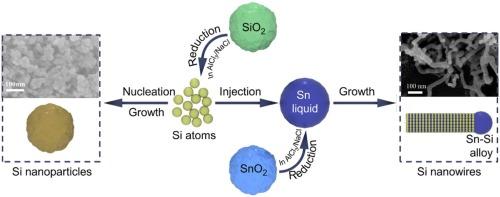当前位置:
X-MOL 学术
›
Nano Energy
›
论文详情
Our official English website, www.x-mol.net, welcomes your
feedback! (Note: you will need to create a separate account there.)
Solid-liquid-solid growth of doped silicon nanowires for high-performance lithium-ion battery anode
Nano Energy ( IF 16.8 ) Pub Date : 2024-11-06 , DOI: 10.1016/j.nanoen.2024.110455 Jiawen Li, Tongde Wang, Yajie Wang, Zhihang Xu, Abdul Mateen, Wei Yan, Haojie Li, Altaf Mujear, Jing Chen, Shengyuan Deng, Guohua Gao, Changlin Zheng, Ye Zhu, Zengfeng Di, Yongfeng Mei, Zhihao Bao
Nano Energy ( IF 16.8 ) Pub Date : 2024-11-06 , DOI: 10.1016/j.nanoen.2024.110455 Jiawen Li, Tongde Wang, Yajie Wang, Zhihang Xu, Abdul Mateen, Wei Yan, Haojie Li, Altaf Mujear, Jing Chen, Shengyuan Deng, Guohua Gao, Changlin Zheng, Ye Zhu, Zengfeng Di, Yongfeng Mei, Zhihao Bao

|
Silicon nanowires (SiNWs) have great potential in electronic devices, sensors, energy storage and conversion devices. Despite various ways to synthesize SiNWs, however, the growth of SiNWs directly from stable, abundant, sustainable silica sources has yet to be achieved. Herein, we report a modified alumino-reduction process of the silica to produce tin (Sn)-doped SiNWs that can be initiated at low temperature (250 °C) based on a solid-liquid-solid growth mechanism in analogy to the well-known vapor-liquid-solid (VLS). In this growth process, the reduced silicon atoms migrate freely in the molten salt and alloy with pre-reduced Sn. The supersaturation of silicon in the Sn-Si alloy leads to the precipitation of single-crystal SiNWs. The prepared SiNWs are of excellent crystallinity and doped with high non-equilibrium concentration (∼ 3.0 at%) of Sn. This process with the solid-liquid-solid mechanism can also be extended to produce other group IV elements-based nanowires such as germanium. In addition, the prepared Sn-doped SiNWs as the anode material in lithium-ion batteries exhibit excellent performance with a high initial Coulombic efficiency of 85.4 %, and a substantial reversible capacity of 1133 mAh g−1 even after 500 cycles at 4 A g−1 . By utilizing the solid-liquid-solid mechanism, this modified alumino-reduction process offers a novel route for synthesizing doped SiNWs, holding promise for diverse applications.
中文翻译:

用于高性能锂离子电池负极的掺杂硅纳米线的固-液-固生长
硅纳米线 (SiNW) 在电子设备、传感器、储能和转换设备方面具有巨大潜力。然而,尽管合成 SiNW 的方法多种多样,但 SiNW 的直接生长来自稳定、丰富、可持续的二氧化硅来源尚未实现。在本文中,我们报道了二氧化硅的改性铝还原工艺,以生产锡 (Sn) 掺杂的 SiNW,该硅氮气可以在低温 (250 °C) 下引发,该硅氮气可以基于类似于众所周知的气-液-固 (VLS) 的生长机制。在这个生长过程中,还原的硅原子在熔盐和具有预还原 Sn 的合金中自由迁移。Sn-Si 合金中硅的过饱和度导致单晶 SiNW 的析出。制备的 SiNW 具有优异的结晶度,并掺杂了高非平衡浓度 (∼ 3.0 at%) 的 Sn。这种具有固-液-固机制的工艺也可以扩展到生产其他基于 IV 族元素的纳米线,例如锗。此外,制备的 Sn 掺杂 SiNW 作为锂离子电池中的负极材料,即使在 4 A g-1 下循环 500 次后,也表现出优异的性能,初始库仑效率高达 85.4 %,并且具有 1133 mAh g-1 的可逆容量。通过利用固-液-固机制,这种改性的氧化铝还原工艺为合成掺杂 SiNW 提供了一条新途径,有望实现多种应用。
更新日期:2024-11-06
中文翻译:

用于高性能锂离子电池负极的掺杂硅纳米线的固-液-固生长
硅纳米线 (SiNW) 在电子设备、传感器、储能和转换设备方面具有巨大潜力。然而,尽管合成 SiNW 的方法多种多样,但 SiNW 的直接生长来自稳定、丰富、可持续的二氧化硅来源尚未实现。在本文中,我们报道了二氧化硅的改性铝还原工艺,以生产锡 (Sn) 掺杂的 SiNW,该硅氮气可以在低温 (250 °C) 下引发,该硅氮气可以基于类似于众所周知的气-液-固 (VLS) 的生长机制。在这个生长过程中,还原的硅原子在熔盐和具有预还原 Sn 的合金中自由迁移。Sn-Si 合金中硅的过饱和度导致单晶 SiNW 的析出。制备的 SiNW 具有优异的结晶度,并掺杂了高非平衡浓度 (∼ 3.0 at%) 的 Sn。这种具有固-液-固机制的工艺也可以扩展到生产其他基于 IV 族元素的纳米线,例如锗。此外,制备的 Sn 掺杂 SiNW 作为锂离子电池中的负极材料,即使在 4 A g-1 下循环 500 次后,也表现出优异的性能,初始库仑效率高达 85.4 %,并且具有 1133 mAh g-1 的可逆容量。通过利用固-液-固机制,这种改性的氧化铝还原工艺为合成掺杂 SiNW 提供了一条新途径,有望实现多种应用。


















































 京公网安备 11010802027423号
京公网安备 11010802027423号